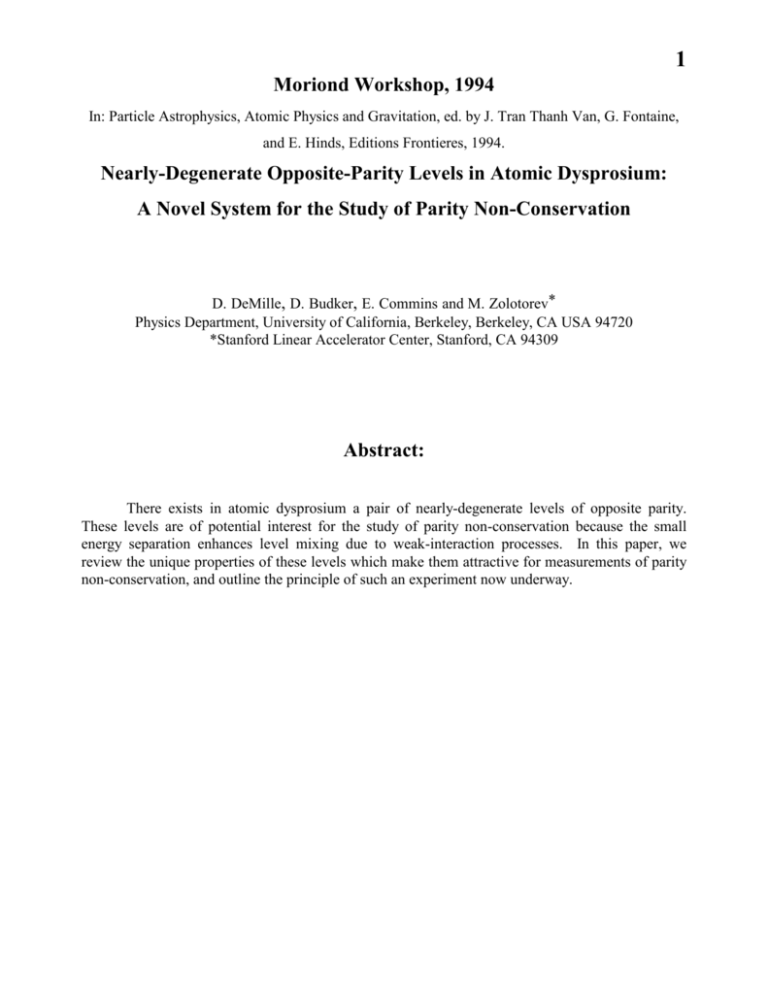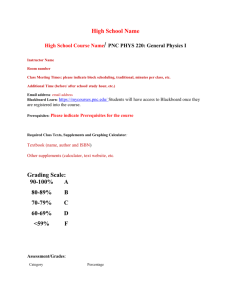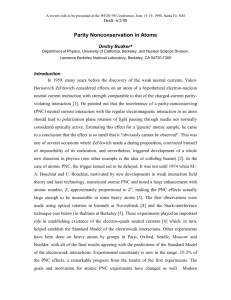Nearly-Degenerate Opposite-Parity Levels in Atomic Dysprosium
advertisement

1 Moriond Workshop, 1994 In: Particle Astrophysics, Atomic Physics and Gravitation, ed. by J. Tran Thanh Van, G. Fontaine, and E. Hinds, Editions Frontieres, 1994. Nearly-Degenerate Opposite-Parity Levels in Atomic Dysprosium: A Novel System for the Study of Parity Non-Conservation D. DeMille, D. Budker, E. Commins and M. Zolotorev* Physics Department, University of California, Berkeley, Berkeley, CA USA 94720 *Stanford Linear Accelerator Center, Stanford, CA 94309 Abstract: There exists in atomic dysprosium a pair of nearly-degenerate levels of opposite parity. These levels are of potential interest for the study of parity non-conservation because the small energy separation enhances level mixing due to weak-interaction processes. In this paper, we review the unique properties of these levels which make them attractive for measurements of parity non-conservation, and outline the principle of such an experiment now underway. 2 Introduction The study of parity non-conservation (PNC) in atoms is now a mature field. Measurements of PNC effects have reached a precision of 2% or better in several elements.1,2,3 Measurements with higher precision are of interest for several reasons. First, it should be possible to observe the nuclear anapole moment, which arises from PNC in the nucleus and induces a nuclear spindependent component of atomic PNC.4 In addition, if PNC can be measured to high precision in a chain of isotopes of the same element, information can be obtained about neutron distributions in the nucleus.5 Finally, if some other method of obtaining neutron distributions is available, measurement of PNC in a chain of isotopes can serve as a high-precision test of the standard model of weak interactions.6,7 Measurement of PNC in the system of nearly-degenerate levels of opposite parity in atomic dysprosium (Z=66) offers the possibility in principle to make such a measurement at a level of precision orders of magnitude better than that achieved so far in other elements. This possibility arises because the small energy splitting enhances the weak-interaction induced mixing between the levels. We describe here the unique properties of this system, and will outline the effort now underway to make a first observation of PNC in dysprosium. The nearly-degenerate levels A (even parity) and B (odd GHz F = 1 2 .5 12 parity) both have angular momentum J=10 and lie 19797.96 cm-1 above the ground level (J=8). (The level structure of atomic Dy is 1 2 .5 tabulated in Ref. 8.) Dysprosium has both even and odd neutron1 1 .5 1 1 .5 number stable isotopes ranging from A=156 to A=164. The magnitude of the energy splitting between A and B is of the order 1 0 .5 1 0 .5 varies greatly among the various HF and IS components. For the 9 .5 9 .5 8 .5 7 .5 0 A typically associated with hyperfine and isotope shifts,9 and thus 8 .5 even isotopes (which have nuclear spin I=0, and thus no hyperfine structure) this splitting ranges from 235 MHz for 156 Dy. The two odd isotopes (161Dy and 162 163 Dy to 4200 7 .5 MHz for B nuclear spin I = 5/2. Fig. 1 shows the hyperfine structure of levels Figure 1: Hyperfine structure of levels A and B for 163Dy. A and B in 163 Dy) both have Dy. The hyperfine components with F=10.5 of 163 Dy are the closest pair, with a separation of only 3.1 MHz. This pair of levels is used in the current search for PNC. 3 Outline of the PNC Experiment In the PNC experiment now underway, we observe Stark-induced quantum beats between levels A and B and look for interference between the Stark amplitude and the much smaller PNC amplitude connecting the two levels. A magnetic field is applied in order to bring Zeeman sublevels of A and B with the same value of mF to near crossing, and thus to enhance the PNC mixing between them. (Fig. 2 shows some of the Zeeman structure of the 163Dy F=10.5 levels of A and B in a weak magnetic field.) An electric field is applied parallel to the magnetic field to induce 100% amplitude of the quantum beats. The Stark and PNC amplitudes have a relative phase of /2 and so do not interfere if the electric field is DC. In order to adjust the phases in such a way as to produce Figure 2: Partial Zeeman structure of the 163Dy F=10.5 interference sublevels of A and B. two is rapidly (non-adiabatically) switched. This scheme of PNC detection was originally p ulse 1 -E p o p u l a te A +E these amplitudes, the polarity of the electric field +E between p ro b e B proposed in a slightly different form for use in the 2s-2p system in hydrogen.10 p ulse 2 -E t 0 T 2 T Figure 3: Electric field pulses used in the nonadiabatic switching scheme. The PNC signal is the fractional difference between the signals obtained with these two pulses. Quantum beats are observed by populating level A instantaneously at time t=0 and probing level B at some later time t=2T. The electric field polarity is switched between the population and probe pulses at t = T (see Fig. 3). Level A is populated by two-step excitation from the ground state via an intermediate odd-parity level with J=9; the corresponding E1 transitions are excited by two consecutive laser pulses at 626 nm and 2614 nm. Level B is probed by excitation to a high-lying even-parity level with another pulsed laser at 571 nm and detection of the subsequent fluorescence. The PNC signal is the fractional difference between the signals from two consecutive populationprobe sequences with opposite ordering of the E-field polarity (Fig. 3). 4 Calculation of the Quantum Beats and the Stark-PNC Interference The Hamiltonian for the 2-level system formed by the nearly-crossed components of A and B (with the same value of F and mF) in the presence of an electric field E parallel to the magnetic field is: iA H 2 dE i dE i iB . 2 (1) Here, A ( B ) is the natural width of level A(B), is the energy splitting in the absence of mixing (determined by the applied magnetic field), i is the PNC matrix element (pure imaginary due to Treversal invariance), and d is the electric dipole matrix element between these sublevels. The experimentally determined values of A , B and d are:9 A = 20 kHz; (2) B < 1 kHz; (3) d(F=10.5, mF=10.5) = 4 kHz/ (V/cm). (4) In addition, the PNC matrix element has been estimated11 using multiconfiguration Hartree-Fock wavefunctions for Dy: 40 Hz . (5) The nonzero value of arises from configuration mixing and core-polarization effects: the dominant configurations of A and B differ by the exchange of an f electron for a d electron, whereas the PNC Hamiltonian mixes only s and p states. As a comparison, it can be noted that the PNC matrix element between the 6p1/2 and 7s1/2 states of Tl has magnitude 100 kHz. The electric dipole matrix element is also suppressed, because E1 selection rules are not satisfied in the transition between the dominant terms of A and B; a typical value for an allowed E1 amplitude is ea0 1 MHz/(V/cm). a 1,2 of the Hamiltonian in The complex eigenvalues 1,2 and corresponding eigenstates b 1,2 eqn. 1 are found by solving the characteristic equation. The linear combination of these eigenstates which corresponds to state A is excited at time t=0: 1 a1 a2 ( t 0) c1 c2 . 0 b1 b2 Just before the electric field switching, the wavefunction has evolved to: (6) 5 a1 a 2 ( t T) c1e i1T c 2 e i 2 T . b1 b2 (7) In the above wavefunction there appears no Stark-PNC interference term, since the PNC matrix element is pure imaginary and the Stark matrix element is real. Non-adiabatic switching of the polarity of the electric field can adjust the relative phases of the PNC and Stark mixing terms to produce interference. After the electric field has been switched, there are new eigenvalues 1,2 and A1,2 . Thus, just after the switching, the wavefunction can be written in the form eigenfunctions B1,2 A1 A2 ( t T) C1 C 2 , B1 B2 (8) where C1 and C2 are determined by setting ( t T) ( t T) . At the time t = 2T of the probe pulse, the wavefunction is: A1 A2 ( t 2T) C1e i 1T C 2 e i 2 T B1 B2 (9) Since the probe pulse couples only to state B, the signal has the form 2 S C1e i 1T B1 C 2 e i 2 T B2 . (10) Fig. 4 shows the measured and expected dependence of the signal as a function of the applied magnetic field near a level crossing. For dE , The signal asymmetry A= S( E E) S( E E) S( E E) S( E E) (11) is linear in . With T, E, and the magnetic field chosen so that (1/T) dE A , the population of state B at the time of the probe pulse is a considerable fraction of the initial population of state A, and the asymmetry A is on the order of (/) 210-3. This asymmetry changes sign with the overall applied magnetic field and with the detuning ; it has the signature of the P-odd, T-even invariant (Ei Ef ) (B B c ) , (12) 6 where the subscripts f and i denote final and initial, and Bc is the magnetic field required to produce an exact level crossing. Systematics and Sensitivity A full analysis of possible systematic effects in the PNC measurement is beyond the scope Figure 4: Magnetic field dependence of the nonadiabatic- of this paper. Briefly, however, switching quantum beat signal near the 163Dy F = 10.5, mF = 10.5 level crossing, which occurs at 1.46 G. The line shows the expected dependence; the points are experimental data. The conditions are: E = 7 V/cm, T = 4 s. The lineshape is asymmetric becasue of contributions from the nearby mF = 9.5 level crossing. several points can be made. First, it can be noted that the availability of multiple field reversals to change the sign of the asymmetry leads to rejection of systematic effects due to stray and nonreversing fields. In particular, we find that the use of balanced E-field switching (i.e., with both polarities for each pulse, as in Fig. 3) greatly suppresses spurious effects due to nonreversing E-fields. In addition, the presence of spurious fields can be detected and corrected for by means of numerous auxiliary measurements using the Dy atoms themselves. It is also of interest to note that the magnitude of a stray or non-reversing electric field required to produce mixing as large as the expected PNC mixing is macroscopic: / d 10 mV / cm. For these reasons, we believe that systematic effects can be controlled to a high level of precision. Study of PNC in the nearly-degenerate levels offers the potential for unprecedented levels of statistical precision in the measurement of PNC effects. This potential arises both because the predicted PNC asymmetry for these levels is large (A 210-3) and because this asymmetry is obtained using E1 transitions in every stage of the experiment, which means that high counting rates can be achieved. Both properties are important because, in the shot-noise limit, the fractional uncertainty in the PNC matrix element is given by ( A N ) 1, where N is the total number of detector counts. Current Status and Conclusion The current statistical sensitivity of our apparatus to the asymmetry A is 5 10 2 / Hz . This sensitivity is limited by two primary difficulties. First, our laser system is far from optimal for 7 the PNC measurement; the pulsed lasers have a repetition rate of 10 Hz, which gives an effective duty cycle of 10 4 . Second, pulse-to-pulse fluctuations in the laser intensities and spectral profiles lead to noise far above the shot noise limit. Nevertheless, it should be possible to unambiguously detect PNC at the predicted level with only a few hours of integration time. Before this is attempted, however, we are investigating in detail all possible sources of systematic effects and attempting to reduce the stray and nonreversing fields now present in our apparatus. With control over these fields at levels similar to those obtained in other PNC experiments and with an optimized laser system, it is a reasonable goal to measure PNC in the nearly-degenerate levels of Dy to a precision of 10 4 or better. References 1 M.C. Noecker, B.P. Masterson and C.E. Wieman, Phys. Rev. Lett. 61, 310 (1988). M.J.D. Macpherson, et. al., Phys. Rev. Lett. 67, 2784 (1991). 3 D.M. Meekhof, et. al., Phys. Rev. Lett. 71, 3442 (1993). 4 V.V. Flambaum and I.B. Khriplovich, JETP 52, 835 (1980); V.V. Flambaum, I.B. Khriplovich and O.P. Sushkov, Phys. Lett. B146, 367 (1984). 5 E.N. Fortson, Y. Pang and L. Wilets, Phys. Rev. Lett. 65, 2857 (1990); S.J. Pollock, E.N. Fortson and L. Wilets, Phys. Rev. C46, 2587 (1992). 6 V.A. Dzuba, V.V. Flambaum and I.B. Khriplovich, Z. Phys. D1, 243 (1986). 7 D.N. Stacey, in Atomic Physics 13, eds. H. Walther, T.W. Hänsch and B. Neizert (AIP, New York, 1993), p. 46. 8 W.C. Martin, R. Zalubas and L. Hagan, Atomic Energy Levels-The Rare Earth Elements (National Bureau of Standards, Washington, DC., 1978). 9 D. Budker, D.DeMille, E.D. Commins and M.S. Zolotorev, Phys. Rev. Lett. 70, 3019 (1993); Phys. Rev. A 50(1), 132, (1994). 10 R.R. Lewis and W.L.Williams, Phys. Lett. B59, 70 (1975). 11 V. Dzuba, V. Flambaum and M. Kozlov, submitted to Phys. Rev. A. 2











